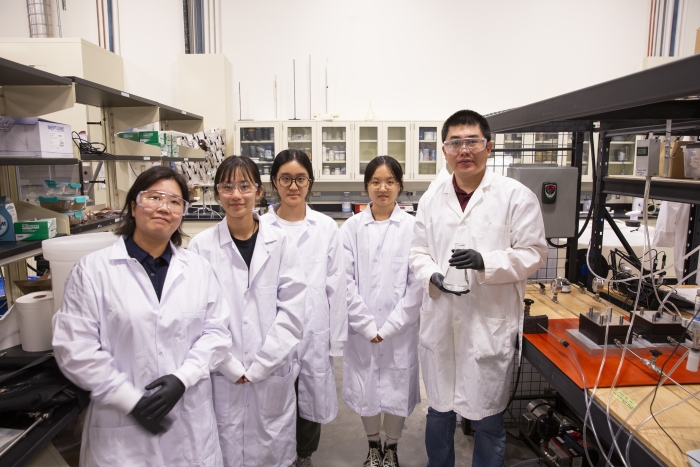Driving green desalination

Fulton Schools researcher Tiezheng Tong is making desalination technology affordable and accessible to inland cities by introducing a water desalination method that will enable municipalities to initiate climate-adaptive water management. Photo by Erika Gronek/ASU
Wilderness survival TV show hosts, pirates and water treatment researchers agree on one thing: Most natural water sources are not safe for drinking. Among the many potential risks is the high salt content, which dehydrates the human body.
Desalination can remove salt from water to make it drinkable, but its high costs and sustainability challenges limit its broader application.
Tiezheng Tong, an associate professor of environmental engineering in the School of Sustainable Engineering and the Built Environment, part of the Ira A. Fulton Schools of Engineering at Arizona State University, is developing sustainable and cost-effective technology to support inland desalination for climate-adaptive water management.
Tong is one of a handful of researchers who received more than $1.2 million in support through the National Science Foundation’s Environmental Convergence Opportunities in Chemical, Bioengineering, Environmental and Transport Systems funding opportunity, which encourages scholars to tackle grand challenges as defined by the National Academies of Sciences, Engineering and Medicine.
Solving water scarcity
Current methods for desalinating naturally occurring water, or brackish water, are costly and consume large amounts of energy. These processes also produce salty brine as a byproduct, with no environmentally friendly disposal options.
“Brackish water desalination is very much needed in water-conscious, inland cities like Phoenix,” Tong says. “We need to be able to use the resources available to us, such as the local brackish water and the sun.”
The team at Tong’s lab is seeking to adapt existing desalination methods to establish Arizona’s brackish water as a prospective alternate water source. Their method challenges the limits of reverse osmosis by combining “salt-leaky” nanofiltration with reverse osmosis to achieve a higher water recovery and a reduced volume of brines.
The researchers will then couple a high-efficiency heat pump with a redesigned fiber-based crystallizer to provide an economically viable approach toward zero liquid discharge while reducing the carbon footprint.
As for the energy required to achieve zero liquid discharge, Tong is turning to Arizona’s most prolific and dependable resource: the sun.
A network to build the framework
From public perception to environmental impact, the team is discovering how to make inland desalination cheaper and more useful for the community at every step in the process. The comprehensive evaluation required Tong to establish an extensive network of multidisciplinary collaborators.
“Tackling so many different aspects of the process required an ambitious team structure,” Tong says. “By collaborating with experts in social sciences, renewable energy, economics and environmental life cycle analysis, we can achieve zero liquid discharge in a way that will provide meaningful results and minimize any potentially harmful environmental impacts.”
Shihong Lin, an associate professor of civil and environmental engineering at Vanderbilt University and one of Tong’s collaborators, says the project’s potential impact is hard to understate.
“I feel excited to have this opportunity to work on addressing the Achilles heel of inland brackish water desalination, which has the potential to play a major role in addressing the freshwater resource challenges due to the shifting climate,” Lin says. “Multidisciplinary collaboration is critical to maximizing the impacts of technological innovation and making sure we are seeking the right solutions that benefit the relevant community.”
Community focus and impact
The ultimate goals for the water treatment industry are zero liquid waste desalination and a zero carbon footprint. Tong’s methodology and thorough evaluation process offer a promising framework for brackish water desalination, a solution many believe to be the future of sustainable water security.
The project is also supporting the local community by creating research opportunities for ASU students from various academic backgrounds.
Tong says he is in the perfect location to tackle this challenge.
“I came to ASU for its history of leading large, impactful projects and to learn from this culture of leading multidisciplinary researchers,” Tong says. “It’s an honor to have the opportunity to lead such a large and talented team as a junior faculty member.”
More Environment and sustainability

A world full of plastic ... not fantastic
Editor’s note: This is the seventh story in a series exploring how ASU is changing the way the world solves problems.When Timothy Long’s kids were growing up, he never let them toss…

Team wins $10M XPRIZE Rainforest competition for novel solution
Several Arizona State University experts are on a team that created a new way to put a price on the rainforest in order to save it, and on Friday they won the top award in the prestigious $10 million…

ASU President Michael Crow named to TIME100 Climate list
Arizona State University President Michael Crow has been named to the 2024 TIME100 Climate list of leaders and innovators driving real climate action.The list includes leaders across a range of…
